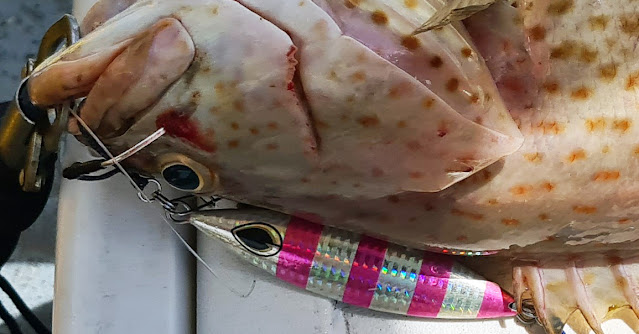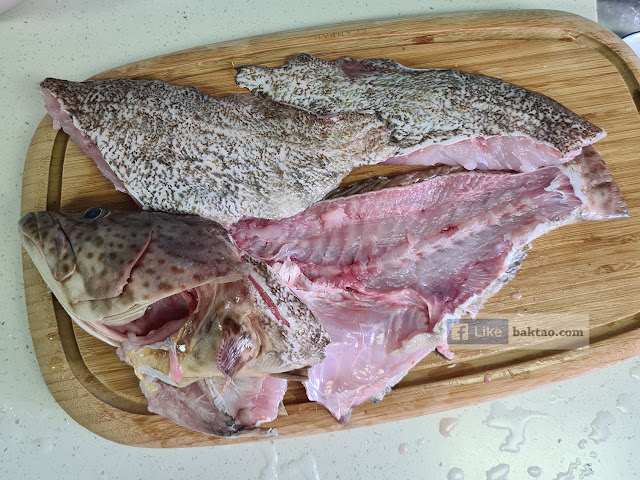 |
| Good take on the Zenaq Ikari 64-5 and Ocea Jigger 1500 |
When you talk to some anglers (even experienced ones) about jigging during Changi Offshore Fishing, they would often give you the incredulous or the "no fish one lah" look. How come? Why are some anglers master rock star jiggers when it comes to Southern Island/St John Island/Pulau Hantu/Kusu but when it comes to Changi, they suddenly turn into baiters?
Is it truly less productive because of the water depth, water visibility and quality? Or is it true that there is less fish and simply not productive? The answer is very simple: those who truly know the meaning of jigging and artificial lures would tell you that is truly requires skill and a whole lot of patience if you're going to do artificial at our Changi seas. Bottom stroking for jigs is also completely underrated and underexplored! Most of us are more used to just buying tungsten micro jig, put on an assist hook and cast it at some sagai boiling. Right? Sagai never eat means fish not biting, come again another day.
But that isn't the case if you truly want to explore the exciting world of jigging and adapt your style to the preference of your game and the terrain.
For Changi Offshore Fishing, you can try a few
styles.
- Light Jigging
- Tai Karuba, Madai or Inchiku
- Slow fall and big jigs
I won't elaborate on no.2 since we all know what it is. It is effective since many of the species at Changi tend to hug the bottom water column. There are sagai and pelagics too but not that much.
One that style that I like a lot during Changi Offshore drift fishing is to stick out a big jig be it a slow fall jig often from 180g to 300g or a general long vertical jig from 100g to 180g. When baiting is tough, trying this out can work in getting a good fish in because of the presentation and size profile of the offering. It may take a lot of perseverance though!
What spots?
When it comes to Changi Offshore, there are usually two general areas that are defined. One if considered "inner" Changi while one is considered "outer" Changi. Inner is usually the area that is before Changi Aviation (
https://goo.gl/maps/d1TSr7n5E8XncXVNA) while "outer" is usually area after that which is usually Changi Naval Base, Johor Shoals and Eastern Anchorage. In general, inner Changi tends to veer more towards brackish and estuary kind of fishing (fishes like snappers, barramundi and groupers) whereas outer Changi does have more bluewater species like pelagics. Outer Changi is also usually deeper.
Personal comment: I actually think the poor water visibility at Changi helps with the jigging. Fishes are less wary and take jigs readily. Of course folks will say the fishes can't see the jigs but if that is the case, the fishes at such areas will all go hungry and die right?
What strokes?
You have to adapt to the spots whether you are at inner and outer Changi. Fish tends to feed on different food and hangs around in different water columns for both. For inner Changi, you're going mostly for bottom hugging species so your strokes will have to be close to the bottom. About 3 to 5 strokes before you let the jig down again. Bottom taps using your jig to break apart sand and coral is important as fishes that hunt in these waters with lower visibility rely much on such actions. The baits also tend to be smaller - think of rubber and light jigs. The only fishes that may feed on big jigs in inner Changi will be groupers and snappers. To keep my options wide open, I also like to make a few jigs to the middle column to tempt species that may transit between inner and outer Changi e.g. queenfish, chermin, mackerels. Oh, another thing, for inner Changi, keep your strokes moderate to slow.
Outer Chang is different and is more towards the Southern Islands in terms of fishing. There will tend to be more fishes like snappers, trevally and even fish like cobia. Using big jigs usually works here and there are also bigger groupers in the 20kg class. I would recommend stroking up to mid water just to have more ROI on your jigging since it is a more complete water column.
Can I cast?
You certainly can! Much of Changi drifting though is through the channels and reef drop offs. You do risk yourself being "sangoat" if you do too much casting. Having sensitive tackle helps detect hard ground instantly and you can lift the jig off quickly. A good captain will drift through the right direction and depth so you can also just do vertical.
When should I jig?
When is very subjective. Hardcore jiggers will say the whole day. Some jiggers will try for 10 minutes and give up once someone catches something on bait. I tend to be in the middle and jig when baiting gets slow or there is a window for jigging. I like to jig just before a tide turns lowest or highest (about 1 hour before low tide or high tide). When the tides transit and currents shift, fish often get active. Certain fish may only feed during this small window if the fishing is bad. Having a big jig will immediately tempt the fish.
Ok, that's about it for ranting today. Ask me anything if you want to know and I'll share. But here is a recent catch on Ah Fong's boat. I got really bored because baiting was poor and the bite was slow, so I put out a slow fall jig and the rest is history.
 |
| When jig takes the biggest catch of the day, it's a good day! But some say the fish might be lo ko. |
 |
| Not fantastic... |
Oh yes, I wish to confess... the grouper done two ways, deep fried and grilled grouper chunks were absolutely fantastic!
 |
| Fillet grouper... |
 |
| Crispy and plain batter |
 |
| Super juicy inside! |
 |
| Grilled with herbs... |
 |
| Very simple pan sear |
 |
| Super juicy! |











Comments